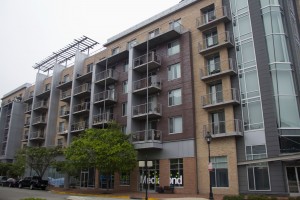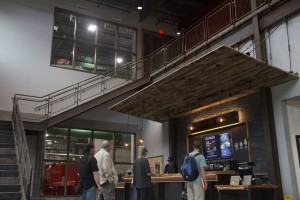From the top of Libby Hill Park, the city’s skyscrapers appear at eye level, the whole city shrunk. The James River looks calm and muted, the train sleeps abed its platform, and the traffic’s noise is blurred by its distance to the park. With this all-encompassing view, a number of buildings stick out as outsiders. While the city skyscrapers rise against the horizon to the west, to the east the housing developments around Rockett’s Landing emerge as the last evidence of man before the James takes over. Most of these views have been created in the past decade, with developers’ increased interest in the East End and the riverfront within it.
Stone Brewery is on its own little island. You are meant to drive to it, to park in its massive parking lot. Walkers are ostracized with run down sidewalks and busy roads to cross. Even though Fulton is just across the street, it feels miles away with the threat of oncoming traffic to overcome. Walking from the west towards Stone Brewery, I leap across railroad tracks and sidewalk pavers tipped over to an unsettling angle from years of decay. To my right is the abandoned and eerie Fulton Gas Works, whose barbed wire fence is littered with “no trespassing” signs. I was not meant to see this side.
The location is in denial of its surroundings, which are composed of busy roads, abandoned buildings, and resting cement trucks. Stone rises at an awkward mix of past and future ground. Across the street lie plans for new waterfront apartments, and developers hope for a chance to disinfect Fulton Gas Works’ poisoned soil.
Like in the rest of the city, conflict surrounds these recent changes. Richmond’s East End faces a constant state of contradiction. Although new houses and apartments mean more money and jobs are coming to the area, these new buildings are a stark contrast to the surrounding neighborhoods’ homes. Rockett’s Landing is already pre-selling its future Riverback Terraces condominiums for the starting rate of $1,100,000. Fulton’s average house price is under $100,000, a tenth of that. Just across the street from Rockett’s Landing lies the newly built, still under construction Stone Brewery. Stone is a giant whose barter into Richmond made history and drove conflict among city officials. While Richmond is home to a number of local craft brewers, Stone Brewery is a California native who desired East Coast expansion, and promises its jobs will open the community to new wealth.
Stone Brewery’s Juliellen Sarver, Community Relations Manager, said that after narrowing down Richmond from 250 sites in the East, the brewery chose Richmond for its growing craft beer love and young, hip scene. After searching for its Richmond location, Stone came across the plot in Fulton whose neighborhood was economically struggling, and welcomed the brewery’s promise of jobs. The Civic Association of Greater Fulton and Stone Brewery Advisory Council, both groups which Juliellen is a member, meet to plan the brewery’s infrastructure and jobs’ impact on the community. Stone desires to connect Richmond’s neighborhoods together, with the river as a main focus. The hundreds of new jobs Stone promises could strongly support Fulton, whose population is just under 4,000. Yet the community still worries that the brewery doesn’t actually care about the locals, and people are wary of the city’s economic development plans which many residents consider corrupt and one sided.
To some, Stone represents corruption long associated with Richmond city government. The millions of dollars Richmond invested in the project could have been broken down into smaller numbers. To city councilman Jon Baliles, Stone Brewery’s placement “goes against Richmond’s small but interconnected neighborhoods. We don’t focus enough on helping the local people that make the neighborhood”. To him, the city’s choice to fund Stone Brewery is symbolic of larger problems the city has faced when allocating its financial resources.
Although Stone Brewery could support the community through its jobs, its patrons are overwhelmingly upper middle class and white, and not representative of Fulton itself. They are unsullied by Fulton’s demolition in the 1970s. The city is angry, but no choices are easy to make. From its roots, Richmond has been built on inequality. Fixing a city with hundreds of years of racial and economic inequality is a tough task with no easy solutions.
Richmond’s eastern silhouette is changing. As Stone Brewery and Rockett’s Landing apartments appear, they will continue to contrast against Fulton’s economic and racial status. We can only hope that the affluence which Stone Brewery attracts will bring new life to Fulton, and the community will thrive once again. As I walk along the docks across the street, I feel a sense of change growing. Groups from far different social classes and from different racial makeups are coming together to grow this forgotten community.


